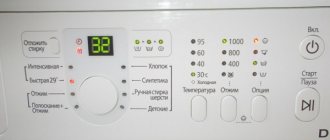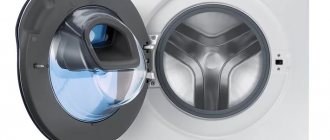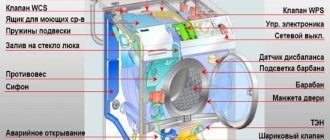How to find out the model of the Atlant washing machine?
On washing machines Zanussi, Electrolux, Ardo, Virpul, Atlant, the service sticker is located on the inner surface of the baseboard or drain filter hatch. On top-loading machines, manufacturers place model information on the inside of the baseboard.
Interesting materials:
How long can you take thyroxine? How long can you travel on one tank? How much alcohol can you bring across the Russian border? How long can you spend alcohol in luggage on a plane? How much alcohol can you bring to Turkey? How much alcohol can you bring? How many cigarettes can you bring to Latvia? How many cigarettes can you bring to Poland? How many cigarettes can you carry on a plane? How much goods can you transport across the Polish border?
Countries of assembly
First of all, let's learn to recognize the parts of the marking that tell us about the country of assembly of the Bosch washing machine. You can determine the origin of a washing machine, first of all, by the letter index, which can be found at the end of the marking designation of a particular model.
- OE - tells us that the machine was made in Russia, Belarus or Ukraine.
- EE - this index indicates that the machine was assembled in Spain.
- BY - tells us that the Bosch washing machine was made in Eastern Europe.
- GB - this index tells us that the Bosch machine was assembled in the UK.
- EU - this index indicates that the washing machine was manufactured in Eastern or Western Europe.
What this or that index prefix means is very important, but you need to understand that not all designations have such prefixes. Moreover, it is impossible to accurately determine the country of origin using the index. A three-digit letter code at the very beginning of the marking will help you do this with a specific Bosch washing machine. Let's give specific examples.
- WAS - means that this model is assembled in Germany.
- WLX - these cars are also assembled in Germany.
- WAE – this code denotes cars made in Poland or Turkey, with the exception of the model with the marking WAE28441, which is assembled in Germany.
- WLF - in most cases, this code denotes equipment assembled in Germany, if the numeric code ends with 4 or 5 - in China.
- WAA is the designation for models made in Turkey.
- WOT – Bosch cars from France.
- WOR - this equipment is assembled in Poland.
- WFX is an old designation that identifies washing machines assembled in Poland.
- WLM is a code that identifies Chinese equipment.
The above codes designate a wide variety of washing equipment from Bosch: narrow, full-size, vertical and front loading.
Countries of assembly
First of all, let's learn to recognize the parts of the marking that tell us about the country of assembly of the Bosch washing machine. You can determine the origin of a washing machine, first of all, by the letter index, which can be found at the end of the marking designation of a particular model.
- OE - tells us that the machine was made in Russia, Belarus or Ukraine.
- EE - this index indicates that the machine was assembled in Spain.
- BY - tells us that the Bosch washing machine was made in Eastern Europe.
- GB - this index tells us that the Bosch machine was assembled in the UK.
- EU - this index indicates that the washing machine was manufactured in Eastern or Western Europe.
What this or that index prefix means is very important, but you need to understand that not all designations have such prefixes. Moreover, it is impossible to accurately determine the country of origin using the index. A three-digit letter code at the very beginning of the marking will help you do this with a specific Bosch washing machine. Let's give specific examples.
- WAS - means that this model is assembled in Germany.
- WLX - these cars are also assembled in Germany.
- WAE – this code denotes cars made in Poland or Turkey, with the exception of the model with the marking WAE28441, which is assembled in Germany.
- WLF - in most cases, this code denotes equipment assembled in Germany, if the numeric code ends with 4 or 5 - in China.
- WAA is the designation for models made in Turkey.
- WOT – Bosch cars from France.
- WOR - this equipment is assembled in Poland.
- WFX is an old designation that identifies washing machines assembled in Poland.
- WLM is a code that identifies Chinese equipment.
The above codes designate a wide variety of washing equipment from Bosch: narrow, full-size, vertical and front loading.
First let's look at the nameplate
The easiest way to determine the manufacturing date of a Samsung washing machine is by looking at the nameplate - an information sticker with brief information. All manufactured equipment must be marked with it at the factory so that the owner can identify the unit even in the absence of a user manual. It shows the name, type of product, service number, main parameters, characteristics and some other information in the form of a table. Among them is the date of manufacture. To find and study an existing nameplate, you must:
- disconnect the washing machine from the electrical network;
- shut off the water supply and disconnect the drain hose;
- turn the machine, providing free access to the rear wall of the case;
- inspect the washer from the back, keeping in mind that the nameplate is most often located in the lower right corner.
Then everything is simple: look for the “Date of Manufacture” column and the digital combination opposite. On Samsung washing machines the month and year of production are indicated, for example, “02.2011”. If there are no extraneous stickers on the case or it is impossible to read anything on it, you will have to decipher the serial number of the existing model.
Automatic washing machines
The market at the end of 1950 could only offer semi-automatic models, especially in the USA and European countries. However, a year later the situation changed dramatically, since at that time the first machine gun appeared. The design of the device was similar to modern models, as it was equipped with a spinning mechanism.
The machine was equipped with two toggle switches - one to start washing, the second to dry. Although modes had to be switched manually, this was another step forward.
Already in 1962, the Miele corporation developed the first automatic machine, to control which you only had to press one switch. The main disadvantage of the models of that time was that the spin was rather weak, since the drum rotated at a maximum speed of 600 rpm.
Although in 1970 a device was introduced with a speed of 1000 revolutions. The washing machine was very noisy, however, it performed its functions at the proper level.
Already in 1978, the same Mila proposed a project for a real machine that received microprocessor control. Then the engineers presented a finished model, in which it was no longer necessary to switch modes. The product became a real prototype of modern solutions and was able to carry out a full washing cycle.
Further, manufacturers began to improve their designs, gradually adding new features, including:
Let's decipher the number
Another way is to determine the year of birth of the washing machine by the serial number. This is an individual multi-valued combination of numbers and letters, which encodes all the necessary information for a specific model. “SERIAL NO” is indicated in the technical passport of the unit, warranty card, nameplate or on a sticker under the hatch door. Therefore, finding the treasured sequence of signs will not be difficult.
The difficulty lies precisely in the encoding: you won’t be able to glance at the number and find out the year of manufacture. The found code will have to be correctly interpreted, since all combinations on Samsung machines are made according to the same principle. Let’s say there is “S/N Y44P5ADC500164W”, which stands for this:
- The last letter – “W” – is a control letter (not always indicated).
- The last five digits – “00164” – are the individual product number.
- The seventh character from the end (if a control letter is specified) – “5” – month of issue. The decoding is as follows: numbers from 1 to 9 determine the sequence of months from January to September, and the Latin letters “ A”, “ B” and “ C” are the remaining months, respectively.
- The eighth character from the edge (if a control letter is indicated) – “C” – year of manufacture. The decoding is as follows: the letter “Y” is encoded 2005, “L” – 2006, “P” – 2007, and “Q”, “S”, “Z”, “B”, “C”, “D”, “F” , “G”, “N”, “J”, “K”, “M”, “N” from 2008 to 2022, respectively.
- The first 3-7 characters are “Y44P5AD” – the factory code with the product group, location and production line code.
General description of different models
Deciphering the markings can reveal much more to us than just the country of origin of the Bosch machine. If we correctly decipher the marking designation, we will learn about the main parameters of a particular model without even looking at its instructions. Let's start with the designations indicating whether the washing machine belongs to a particular series. Today, Bosch produces several lines of washing machines: 2 Classixx, 4 Maxx, 6 Avantixx, 8 Logixx, etc.
There are rulers that are designated by a group of letter symbols. We decided to focus your attention on them.
- WAE - this code designates the standard Maxx 6 with or without a display.
- WLX – with this code the manufacturer designates a Maxx 5 with a narrow body and a display (in some cases there is no display).
- WFR - this three-digit code indicates a full-sized Bosch Maxx Comfort washing machine with front loading and a good display.
- WAA - having seen this code, we should know that this is a Classixx 5 washing machine with a display.
- The WFX is a standard Maxx Advantage with an excellent display.
- WOT, WOR - and these codes, as you may have guessed, designate Bosch top-loading washing machines.
- WFCX - This rare four-digit code points us to the Maxx Advantage with a custom narrow body and screen.
We have given quite a few examples, but have not yet fully disclosed any marking designation. The time has come to move on from scattered examples to practical decoding. Let's take a closer look at the Bosch WLT20271OE washing machine.
The first letter of the marking designation is constantly repeated. Whatever model you take, it will start with W. Why is this so? Yes, because W is a washing machine. The second letter will depend on the type of washing unit we have to deal with. In our case it is the letter L, but the letters O, A, K or I can be used:
- L – washing machine with a narrow body 45 cm with horizontal loading;
- I – built-in machine with horizontal loading;
- O – vertical loading washing machine;
- A – a machine that has a depth of 60 cm and horizontal loading;
- K – this washing machine is capable of drying clothes.
The third letter of the marking designation indicates the series to which a particular model belongs. To help you understand what this means, let's give specific examples. In our case it is the letter T, but it could be K, G, H, S, W or Y.
- The letters K or T indicate that the model belongs to the 6 series.
- The letters G or H indicate that the machine belongs to the 4th series.
- The letters S or W tell us that the washer is from the 8th series.
- The letter Y identifies the machine as a Home Professional appliance.
We continue to decipher the marking designation. After the third letter we have the number 20. It indicates the maximum spin speed. What options are there: 20 – 1000 rpm, 24 – 1200 rpm, 28 – 1400 rpm, 32 – 1600 rpm, 36 – 1800 rpm, 40 – 2000 rpm.
The next two digits indicate the control type of the Bosch washing machine. In our example, the numbers are 27, they mean electronic control. There is also mechanical control, but it is almost never found nowadays. The last number indicates the design of the machine, in our case 1 – classic design. Most models are produced only in the classic design, so the number 1 is invariably present in all markings.
Let's decipher the number
Another way is to determine the year of birth of the washing machine by the serial number. This is an individual multi-valued combination of numbers and letters, which encodes all the necessary information for a specific model. “SERIAL NO” is indicated in the technical passport of the unit, warranty card, nameplate or on a sticker under the hatch door. Therefore, finding the treasured sequence of signs will not be difficult.
The difficulty lies precisely in the encoding: you won’t be able to glance at the number and find out the year of manufacture. The found code will have to be correctly interpreted, since all combinations on Samsung machines are made according to the same principle. Let’s say there is “S/N Y44P5ADC500164W”, which stands for this:
- The last letter – “W” – is a control letter (not always indicated).
- The last five digits – “00164” – are the individual product number.
- The seventh character from the end (if a control letter is specified) – “5” – month of issue. The decoding is as follows: numbers from 1 to 9 determine the sequence of months from January to September, and the Latin letters “ A”, “ B” and “ C” are the remaining months, respectively.
- The eighth character from the edge (if a control letter is indicated) – “C” – year of manufacture. The decoding is as follows: the letter “Y” is encoded 2005, “L” – 2006, “P” – 2007, and “Q”, “S”, “Z”, “B”, “C”, “D”, “F” , “G”, “N”, “J”, “K”, “M”, “N” from 2008 to 2022, respectively.
- The first 3-7 characters are “Y44P5AD” – the factory code with the product group, location and production line code.
Having such a decoding in front of you, it is not difficult to determine that the machine with the service number “Y44P5ADC500164W” was released in May 2012. The main thing is to carefully count and correlate the signs with the coding explanation. Then the year of manufacture of the Samsung washing machine can be recognized quickly, accurately and without problems.
Interesting:
- Share your opinion - leave a comment
The serial number of a Samsung washing machine can be deciphered and you can find out where the washing machine was manufactured.
You can also get an answer to the question of how to find out the production date of a washing machine.
The designation of the model number of washing machines indicates the year when the model was developed and production began, but it must also be taken into account that washing machines can be produced for several years.
What can you wash in a machine?
It turns out, not only clothes and underwear.
Americans invented a washing machine for glasses
. After 40 minutes of washing, the consumer receives crystal clear glasses. Apparently, it is used in particularly difficult cases when wiping is not enough.
The Spaniards went further and invented a washing machine for animals
. The pet is placed inside and jets of warm water are sprayed on it from all sides. Although this invention is more like a shower. After all, it sounds somehow creepy: delicate washing of animals in a machine.
Article on the topic: How to unlock the remote control for a sharp TV











